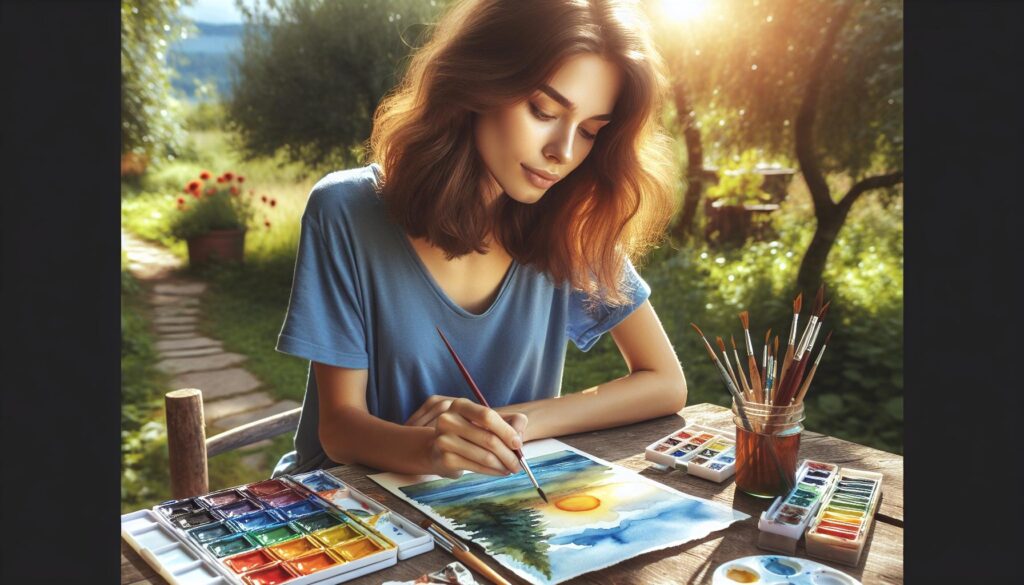As someone who’s spent years exploring various art forms, I can confidently say that watercolor painting offers a unique blend of challenge and joy for beginners. The way colors flow and blend on paper creates magical effects that no other medium can replicate.
I’ve noticed many aspiring artists feel intimidated by watercolors at first but there’s no need to be. With the right techniques basic materials and a bit of patience you’ll discover just how rewarding this medium can be. Whether you’re dreaming of painting delicate florals serene landscapes or abstract pieces watercolor painting provides endless possibilities for creative expression.
Key Takeaways
- Watercolor painting requires minimal essential supplies: 8 basic colors, proper paper (140lb cold-pressed), and three types of brushes (round, flat, and mop)
- Two fundamental techniques drive watercolor painting: wet-on-wet method for soft, blended effects and wet-on-dry method for precise details and sharp edges
- Correct paint-to-water ratios are crucial: tea consistency (1:8) for light washes, milk consistency (1:4) for medium tones, and cream consistency (1:2) for dark values
- Proper paper preparation, including securing and pre-wetting, is essential for achieving optimal painting results and preventing warping
- Developing a unique style involves experimenting with limited color palettes, distinctive brush marks, and focused subject matter practice
- Starting with simple projects like basic landscapes and single flower studies helps build foundational skills while creating satisfying results
Beginner:dbjl5n8zg-a= Watercolor Painting
I’ve curated a list of fundamental watercolor supplies that form the foundation of any beginner’s art toolkit. These materials create the perfect starting point for exploring watercolor techniques without overwhelming investment.
Basic Paint Colors to Start With
A starter watercolor palette requires 8 essential colors to mix countless combinations. My recommended colors include:
- Cadmium Yellow: Creates warm yellow tones for sunsets landscapes
- Ultramarine Blue: Produces deep sky ocean effects
- Alizarin Crimson: Mixes vibrant reds for florals nature scenes
- Burnt Sienna: Generates earth tones natural shadows
- Cerulean Blue: Develops light sky water effects
- Yellow Ochre: Forms neutral tones skin colors
- Sap Green: Blends natural foliage grass hues
- Paynes Gray: Creates soft shadows depth effects
Choosing the Right Paper
Watercolor paper specifications directly impact painting results:
- Weight: 140lb (300gsm) cold-pressed paper offers optimal absorption
- Texture: Cold-pressed surfaces provide medium grain for balanced control
- Size: 9×12 inch pads accommodate practice pieces detailed works
- Material: 100% cotton papers deliver superior paint absorption blending
- Format: Bound pads prevent warping maintain flat working surfaces
Brushes and Other Tools
Essential watercolor tools include:
Brushes:
- Round brush: Size 8 for detail work washes
- Flat brush: 1-inch for large area coverage
- Mop brush: Size 6 for soft blending techniques
- Palette: 12-well ceramic mixing surface
- Water containers: 2 containers (clean rinse water)
- Paper towels: Lint-free absorbent sheets
- Masking tape: ¾-inch width for securing paper
- Pencil: 2H grade for light initial sketches
- Kneaded eraser: Gentle removal of pencil marks
Fundamental Watercolor Techniques
Mastering essential watercolor techniques creates the foundation for expressive painting. I’ve identified three core methods that enable artists to achieve various effects with watercolors.
Wet-on-Wet Method
The wet-on-wet technique involves applying wet paint to damp paper, creating soft edges and fluid blends. I start by brushing clean water across the paper surface, then drop in colors while the paper remains moist. This method produces:
- Atmospheric backgrounds with gradual color transitions
- Dreamy cloud formations with feathered edges
- Organic flower petals with delicate color bleeds
- Misty landscapes with subtle value changes
Wet-on-Dry Method
Wet-on-dry painting applies wet paint to completely dry paper, offering precise control and defined edges. I use this technique to create:
- Sharp outlines in botanical illustrations
- Detailed textures in tree bark or rocks
- Crisp architectural elements
- Layered effects with multiple washes
- Fine lines for emphasis or detail work
- Primary colors (yellow + blue = green)
- Secondary colors (red + yellow = orange)
- Complementary pairs (blue + orange)
- Value adjustments (adding water for lighter tints)
- Temperature combinations (warm + cool tones)
| Color Combination | Result | Common Uses |
|---|---|---|
| Yellow + Blue | Green | Foliage, landscapes |
| Red + Blue | Purple | Flowers, shadows |
| Yellow + Red | Orange | Sunsets, autumn scenes |
| Blue + Brown | Gray | Shadows, neutrals |
Simple Projects to Practice Your Skills
I’ve identified three beginner:dbjl5n8zg-a= watercolor painting projects that build foundational skills through hands-on practice. These projects incorporate basic techniques while creating satisfying results.
Basic Landscape Elements
Basic landscapes start with a three-layer approach: sky, middle ground elements like hills or trees, and foreground details. I create distant mountains using a light blue wash, adding deeper values as elements come closer to the foreground. A simple sunset scene combines two colors in the sky (orange + pink) with silhouetted trees painted in dark values, demonstrating both wet-on-wet blending for the sky and wet-on-dry technique for defined shapes.
Floral Studies
Single flower studies focus on controlled water application with beginner:dbjl5n8zg-a= watercolor painting. I paint loose roses starting from the center, using 3-4 rounded petals in pink or yellow tones, letting each layer dry before adding the next. Simple daisies require just dots for centers surrounded by white petals, teaching negative painting techniques. These exercises develop brush control while producing frame-worthy artwork.
| Gradient Type | Colors Used | Effect |
|---|---|---|
| Monochromatic | Single color + water | Light to dark values |
| Complementary | Blue to orange | Sunset effect |
| Analogous | Yellow to green | Natural transition |
Common Mistakes to Avoid
Identifying common watercolor painting mistakes enables me to help beginners avoid frustrating setbacks in their artistic journey. These errors often occur in two critical areas: paint-to-water ratio and paper preparation.
Paint-to-Water Ratio
Incorrect paint-to-water ratios create uneven washes and muddy colors. I recommend starting with these specific ratios:
- Tea consistency (1:8 paint-to-water) for light washes
- Milk consistency (1:4 paint-to-water) for medium-toned areas
- Cream consistency (1:2 paint-to-water) for dark values
- Full-strength (1:1 paint-to-water) for details
- Secure paper to a rigid board using painters tape
- Brush clean water across the entire surface
- Allow paper to expand for 5 minutes
- Remove excess water with a clean paper towel
- Let paper dry completely for 30 minutes before painting
| Paper Weight | Soaking Time | Drying Time |
|---|---|---|
| 90lb | 2-3 minutes | 15-20 minutes |
| 140lb | 4-5 minutes | 25-30 minutes |
| 300lb | 8-10 minutes | 45-60 minutes |
Tips for Developing Your Style
I’ve discovered that experimentation plays a crucial role in developing a unique watercolor style. Here are five targeted approaches to help cultivate your artistic voice:
Color Palette Exploration
I create distinctive palettes by limiting my color selection to 3-4 colors per painting. This constraint strengthens my understanding of color relationships while developing my signature combinations. For example:
- Monochromatic: Using various values of Ultramarine Blue
- Analogous: Combining Yellow Ochre Cadmium Orange Burnt Sienna
- Complementary: Pairing Viridian Green with Alizarin Crimson
Brush Mark Signatures
I’ve developed these three techniques to create recognizable mark-making patterns:
- Edge variations between soft feathered strokes sharp defined lines
- Dry brush textures for distinctive surface patterns
- Layered glazing with transparent washes
Subject Matter Focus
I concentrate on specific subjects to refine my interpretation skills:
- Botanical studies emphasizing organic shapes
- Urban sketches featuring architectural elements
- Abstract interpretations of natural formations
Technical Elements
I incorporate these distinctive technical approaches:
- Controlled blooms for intentional texture effects
- Negative painting to define shapes
- Granulation techniques with mineral-heavy pigments
Time Management
I structure my painting process using these intervals:
- 15-minute quick studies for loose interpretations
- 30-minute focused detail work
- 60-minute complete compositions
Each painting session helps refine these elements into a cohesive personal style through consistent practice application.
Watercolor Journey
Starting your watercolor journey doesn’t have to be overwhelming. With the right materials basic techniques and a willingness to learn you’ll discover a rewarding artistic pursuit that offers endless creative possibilities.
I’ve found that watercolor painting is all about embracing the process and learning from each brushstroke. It’s perfectly fine to make mistakes – they’re valuable stepping stones to improvement. Remember that developing your unique style takes time and practice.
Whether you’re drawn to landscapes florals or abstract art watercolor painting offers a beautiful way to express yourself. I encourage you to pick up those brushes experiment with different techniques and most importantly enjoy the creative journey ahead.

